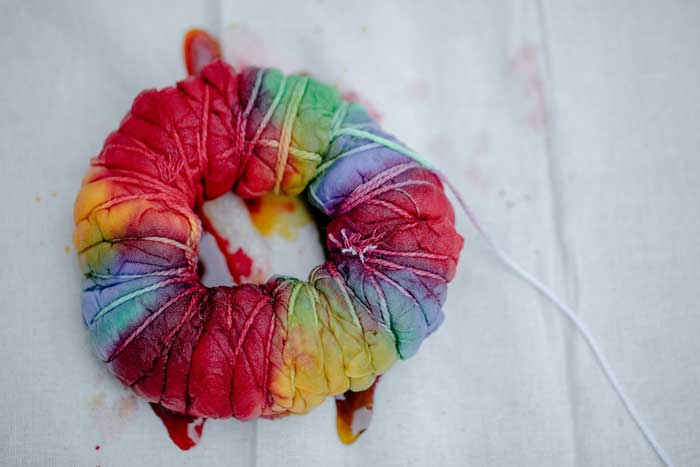
The Revolutionary Shift from Dyes to Pigments
The transition from dyes to pigments in the textile industry represents a pivotal shift towards sustainable and high-performance coloration methods, says Mihir V Shah
Indian Textile Industry is in the midst of a quiet but significant revolution – driven by technological advancements and environmental considerations – The tectonic shift from dyes to pigments for their colouring needs.
Traditionally, textiles have heavily relied on dye-based colouring methods, which involve the absorption of colour molecules into fibres. Environmental consciousness and the impact of using dyes on human health led the colour companies experiment with colouring agents and come up with Pigments and Pigments Dispersions that offer superior stability, durability, and environmental benefits over traditional dyes.
Pigments offer massive environmental benefits since they are designed to be ecofriendly and reduce the use of hazardous chemicals. In addition, it minimises the waste water discharge during and after application. Stricter regulations on hazardous chemicals in dyes in the global context have pushed textile manufacturers to find safer alternatives, making pigments a more attractive choice.
Pigments adhere to textile fibres through physical binding rather than absorption, resulting in superior colour-fastness against fading from exposure to light and washing. In addition, pigments offer a broader range of colour options and can be applied to various textile materials, including natural fibres like cotton and wool and synthetic fibres like polyester, rayon, etc. Advanced pigment dispersion technologies ensure uniform distribution and adherence of pigments to textile fibres, enhancing colour consistency and durability.
While initial pigment costs can be higher than dyes, their superior colour retention often results in longer-lasting fabrics, reducing the need for frequent re-dyeing and overall production costs.
Innovative technological advancements in application methods of pigments in the Indian textile industry are reshaping traditional dyeing and printing practices, offering new avenues for vibrant, durable, and sustainable textile coloration. The industry is moving to the use of pigments to enhance product quality, sustainability, and design flexibility. From digital printing technologies that offer precision and customisation to eco-friendly dyeing processes like cold pad batch dyeing, the application methods with pigments drive efficiency, reduce environmental impact, and meet diverse market demands. As the industry continues to innovate, pigment-based applications are poised to play a pivotal role in shaping the future of textile coloration in India and beyond.
Indian Textile industry, across all categories – Fashion and apparel, home textiles and industrial textiles are now shifting to pigments for their colouring needs. Leading fashion brands and apparel manufacturers are increasingly adopting pigment-based printing and dyeing methods to achieve vibrant colours and meet stringent environmental regulations.
Pigment printing is gaining popularity in home textile applications like curtains, upholstery, and bedding due to its durability and colourfastness properties. Industries such as automotive textiles and outdoor fabrics benefit from pigment-based coloration, which offers resistance to abrasion, UV exposure, and harsh weather conditions.
The transition from dyes to pigments in the textile industry represents a pivotal shift towards sustainable and high-performance coloration methods. With advancements in pigment technology and growing environmental awareness, pigments are poised to redefine the standards of colour quality, durability, and eco-friendliness in textile manufacturing. As stakeholders continue to prioritise innovation and sustainability, the adoption of pigment-based solutions is expected to accelerate, driving a more vibrant and environmentally responsible future for the textile industry.
Top of Form
Bottom of Form
As leaders in colourants, we at Vipul Organics have been at the forefront of this revolution and have created many innovative products with years of providing customer-centric solutions through rigorous R&D. Our SunPrint Range of Pigment Dispersions is completely focused on the Textile Industry and is appreciated by Indian and global customers. It has set new benchmarks in quality and certification. With the complete range of over 200 products, approved at ZDHC LEVEL 3, the highest in the industry, we are showcasing our commitment to excellence and environmental responsibility.
The reason that this has been possible is because of our planned backward-forward integration, from manufacturing pigment powder to pigment dispersion. This integrated approach not only ensures the highest quality of pigment dispersions but also allows for better control over production processes and costs. By managing the entire supply chain, we offer cost-effective solutions without compromising on quality.
The transition from dyes to pigments in the textile industry represents a pivotal shift towards sustainable and high-performance colouration methods. With advancements in pigment technology and growing environmental awareness, pigments are poised to redefine the standards of colour quality, durability, and eco-friendliness in textile manufacturing. As stakeholders continue to prioritise innovation and sustainability, the adoption of pigment-based solutions is expected to accelerate, driving a more vibrant and environmentally responsible future for the textile industry and we at Vipul Organics will be there to contribute meaningfully with our wide repertoire of Pigment products.
About the author:

Mihir V Shah is the Executive Director at Vipul Organics. Vipul Organics is a leading name in Dyes and Pigments in the Indian and global markets. Shah is Masters in Pharmacy and Management from Narsee Monjee Institute of Management Studies, Mumbai. After his internship with Glaxo Smithkline Pharmaceuticals Gmbh, he joined Vipul organics in 2015 and started his understanding of the business across its verticals. As part of the next gen in the company, he presented his vision to the management and then took over as the Whole Time Director of the company.Top of Form




